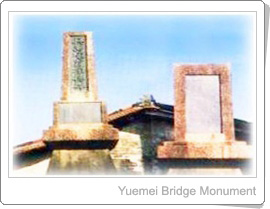 |
 |
|
 |
 Ancient Yuemei Bridge Ancient Yuemei Bridge
Yuemei Bridge was constructed during the Japanese colonial era; besides being the communication line for Shanlin Township, it is also known as the main traffic artery since the villagers from Sanmin and Jiasian Townships must also take the National Route 21 passing through Lingkou when going to Kaohsiung downtown. Those who served in the army at Yuantan, Kouai and Pujinglin during the early days also loved to wander on top and beneath the bridge, where crystal clear water flows in Nanzihsian River, with the charming wheat fields and flourishing banana woods on both sides of the river. |
 |
 Yuemei Bridge Monument Yuemei Bridge Monument
There was no bridge here for a long period of time, thus one relied on bamboo rafts during the rainy season, and depended on sidewalks during the draught season as the major traffic route. The exportation of this village’s crops were extremely inconvenient, and some people even lost their precious lives; therefore, the village longed to build a bridge for many years, thus it was suggested to save up the budget every year to build the bridge. With the intervention of the prefecture in 7th year of Showa Era (1932), one thousand dollars were offered to subsidize the engineering fees, in addition to nine thousand dollars to construct the bridge, which was carried out by Jiasian Oil Fields Digging Department.
In consideration of the growing importance of this road, the suggestion to build a bridge also became more comprehensive. The prefecture government invested 150 thousand dollars as the engineering budget with the subsidy from the exchequer, and began the two-year planning and execution during the 9th and 10th years of Showa Era (1934~1935); the construction began in February of the 10th year of Showa Era (1935), and was completed on November 3rd that year. The new bridge was composed of reinforced concrete, with a width of 5 meters and a length of 230 meters; it was strong and pleasing, which conformed to the concept and the time period. The village and enterprises donated 15 thousand dollars to the engineering fees, and the other 10 thousand dollars were paid by Japan Oil Company. The benefits that this bridge construction brought for the local area development was expected soon, thus the villagers decided to establish a monument to express their sincere gratitude and satisfaction. |
|
 |
 |
 |
|
|
|
|
|